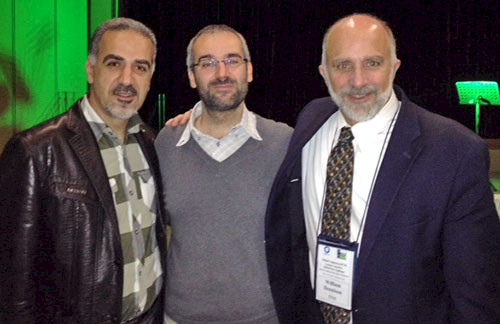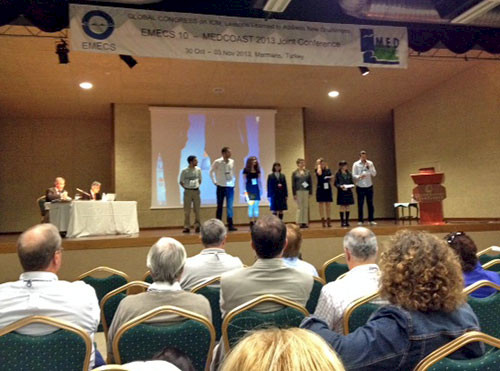MEDCOAST 2013 and EMECS 10 conference: Turkish baths, Red Sox baseball, new colleagues
Bill Dennison ·The Environmental Management of Enclosed Coastal Seas (EMECS) was established to share knowledge between the Seto Inland Sea, Japan, Chesapeake Bay, U.S.A., the Baltic Sea and the Mediterranean Sea. MEDCOAST is the Mediterranean Coastal Foundation, which has been working toward the sound coastal management practices in the Mediterranean and the Black Sea countries. These organizations came together to produce a combined conference program. Drs. Bob Summers (Maryland Secretary for Environment) and Wayne Bell (Washington College emeritus) are attended. The other Marylanders were Lee Currey (Maryland Department of Environment), Dave Nemazie (University of Maryland Center for Environmental Science), and David Carroll (former Secretary Maryland Department of Environment). The University of Maryland Center for Environmental Science helped host the most recent EMECS meeting in the Inner Harbor of Baltimore in 2011. Unfortunately, the timing of the EMECS 9 meeting was compromised by Hurricane Irene that led to travel difficulties and many cancelled talks, but we still had a good exchange of ideas and shared experiences.

When the Japanese delegation visited Baltimore in 2010 in advance of the EMECS 9 meeting, the local organizing committee of Marylanders sponsored a visit to Orioles Park at Camden Yards to watch the Baltimore Orioles play baseball. We were able to rent a private box (at the time, the Orioles had experienced 13 consecutive losing seasons). As part of our visit, we visited with a young relief pitcher from Osaka, Japan, Koji Euhara, and he graciously posed for photographs, signed baseballs and baseball hats for our Japanese visitors. Three years later, the Orioles have a winning team and Koji was traded to the Boston Red Sox. I arrived in Marmasis, Turkey after a long trip from Maryland to New York to Istambul to Dalaman to Marmasis. Game 6 of the 2013 World Series between the St. Louis Cardinals and the Boston Red Sox was being played at Fenway Park during the middle of the Turkish night. I used the live streaming radio via wireless internet using a Major League Baseball app to listen to the Red Sox win the 2013 World Series. Koji was the closer for the Red Sox and he struck out the final batter to end the series. I was the only person at the conference to know the result of the World Series on the next morning and I was the first speaker of the day. So I was able to announce to my EMECS colleagues that Koji had been able to help the Red Sox win the World Series - coming full circle from our visit with Koji in 2010.
Marmasis is a coastal resort town with an extended waterfront, marina and cruise ship facility. We arrived at the very end of the summer resort season and the conference was conducted in a large resort hotel with swimming pools, restaurants, and various amenities. We took a tour around the town and visited an old castle dating back to the 1522 which now serves as a museum. We watched dozens of yachts sailing in the enclosed natural harbor of Marmasis. The promenade along the shore was lined on one side by many restaurants and stores that sold Turkish coffee and Persian rugs and on the seaside by large yachts from all over the world.

The conference organizers produced two large volumes of conference papers which we received upon arrival. In addition, extended (2 page) abstracts were produced. Having these written products was helpful for the diversity of languages that attendees spoke. My Australian colleagues Jon Brodie, Jane Waterhouse and Eric Wolanski were in attendance and it was nice to catch up with them. There was a wide diversity of issues presented at the conference and many different types of science and management conducted. It is always valuable to be exposed to the different approaches taken by people from different countries. Both posters and presentations were presented and there were many business cards exchanged throughout the conference. The style of the conference was very different than American conferences, and I particularly enjoyed the field trips that were built into this conference. Wandering around with colleagues allowed for some good informal discussions. The conference was held at an all-inclusive resort and I was able to use the breaks to swim and experience the Turkish baths. I spent time getting to know two colleagues in particular - Homayoun 'Homii' Khoshravan from the Caspian Sea Research Center in Iran and Gabriele Pieri from Istituto di Scienza e Tecnologie in Pisa, Italy. In addition to sharing our scientific stories, we learned about each other's daily lives and families.

The conference had a session focused on Chesapeake Bay in which Dave Nemazie spoke about BayStat and about Chesapeake science communication; and Lee Currey talked about the MAST program for engaging stakeholders in the Water Implementation Program and the Total Maximum Daily Load (TMDL) program, or 'nutrient diet'. In other sessions, I talked about developing environmental report cards and about the Maryland approach to adaptation to climate change. I enjoyed listening to the diversity of topics from people from a diversity of institutions.
The conference was closed out by a synthetic summary by Professor Watanabe, a conference declaration by Wayne Bell and a very nice conference declaration co-authored by graduate students from Turkey, Japan and the United States. The next EMECS conference, scheduled for August 2016, in St. Petersburg, Russia was announced as well. The conference banquet was dinner followed by dancing and late night carousing, capping an interesting conference.

About the author
Bill Dennison

Dr. Bill Dennison is a Professor of Marine Science and Vice President for Science Application at the University of Maryland Center for Environmental Science.

